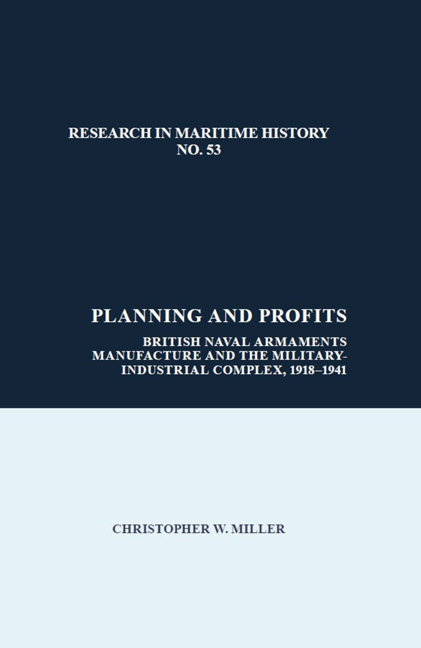 Planning and Profits
Planning and Profits Book contents
- Frontmatter
- Contents
- Acknowledgements
- About the Author
- List of Tables and Figures
- List of Illustrations
- List of Abbreviations
- A Note on Definitions
- Part One Introduction
- Part Two Industry and the Navy before Manchuria, and the Establishment of the Warshipbuilders’ Committee, 1919–1931
- Part Three The Formation of a National Government, the Far East, and the PSOC Approach to Industry, 1931–1934
- Part Four The Ultimate Potential Enemy and Rearmament Planning, 1934–1936
- 7 Towards Rearmament, 1934–1935
- 8 The White Papers, 1935–1936
- Part Five The Inskip Era and War, 1936–1941
- Conclusion and Retrospective
- Appendices
- Bibliography
- Index
7 - Towards Rearmament, 1934–1935
from Part Four - The Ultimate Potential Enemy and Rearmament Planning, 1934–1936
- Frontmatter
- Contents
- Acknowledgements
- About the Author
- List of Tables and Figures
- List of Illustrations
- List of Abbreviations
- A Note on Definitions
- Part One Introduction
- Part Two Industry and the Navy before Manchuria, and the Establishment of the Warshipbuilders’ Committee, 1919–1931
- Part Three The Formation of a National Government, the Far East, and the PSOC Approach to Industry, 1931–1934
- Part Four The Ultimate Potential Enemy and Rearmament Planning, 1934–1936
- 7 Towards Rearmament, 1934–1935
- 8 The White Papers, 1935–1936
- Part Five The Inskip Era and War, 1936–1941
- Conclusion and Retrospective
- Appendices
- Bibliography
- Index
Summary
By the end of 1935, Britain's international security looked far less certain than it did in the spring of 1931 because now there were three credible adversaries: Japan, Germany and Italy. As a direct result of these developments, the tentative work of the CID to explore, if not tackle, industrial and material deficiencies that began after Manchuria took on even greater meaning and urgency. By the time that Mussolini's forces had invaded Abyssinia (modern-day Ethiopia) in October 1935, a two-front war in Europe and Asia requiring a renewed navy and an expanded air force was considered by the CID to be a very real possibility. Moreover, the idea of a major rearmament effort entered, finally, into in public consciousness.
Political Background
Of course, the first indications of a two-front threat during this time came not from Italy but from Nazi Germany, which had emerged as a force under Hitler in early 1933 and withdrew from the Geneva disarmament conference that October. The deterioration of relations with Germany prompted the CID to formally plan based on a twin German-Japanese threat by the beginning of 1934. Cabinet responded to the CID's concerns with the largely Hankey-led initiative known as the Defence Requirements Committee – another CID subcommittee. The decision by Cabinet to grant the DRC approval to examine the “worst problems in British defence” has been characterised by some historians as the “first major step” in war planning since 1918 and the “beginning of rearmament.” As to the first of these contentions, it was nothing of the sort. While it may have been an incremental change in top-level foreign policy insofar as it was a clear recognition by Cabinet of the need to improve the condition of British defences, as far as planning is concerned it was only a continuation of the work of the supply subcommittees. Deficiency hypotheses had been circulated since 1931, so while the recognition of the German threat at the end of 1933 – and the formation of a committee with an explicit remit to discuss deficiencies – has perhaps understandably been taken as a point of departure for the study of rearmament policy, in terms of industrial deficiencies and planning the work was already well under way, as evinced by the long process which led to the establishment of the Advisory Panel.
- Type
- Chapter
- Information
- Planning and ProfitsBritish Naval Armaments Manufacture and the Military-Industrial Complex, 1918–1941, pp. 125 - 142Publisher: Liverpool University PressPrint publication year: 2018


